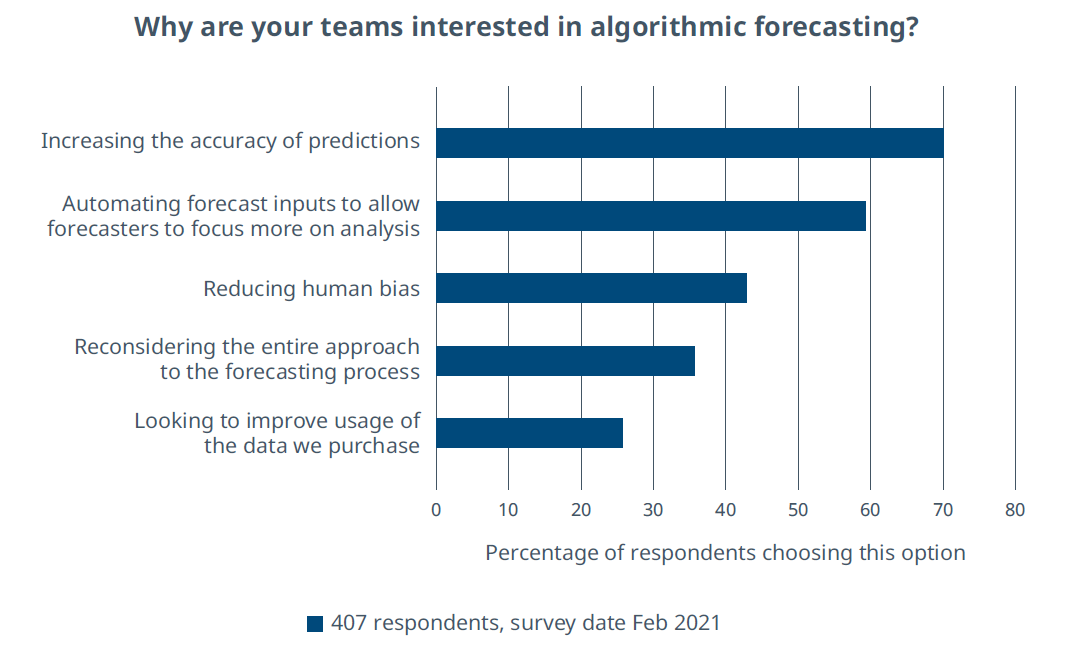Designed specifically for the challenges and modeling approaches of the life sciences industry
















- Locations
- United States
- US Blogs
- Algorithmic Forecasting - a Game Changer for the Pharmaceutical Industry?
The biggest repetitive task in pharma forecasting is data wrangling. Forecasters have to gather updates from multiple stakeholders and affiliates – which can take weeks – then run all of the calculations, while continuously tweaking numbers and inputs. As the quantity of data involved in this process expands, it will eventually render this process obsolete, particularly for organizations that are still using spreadsheets to do most of the work.
But Algorithmic Forecasting (AF) offers a better way.
AF uses artificial intelligence and automated algorithms to analyze real-time data feeds and interpret trends to forecast commercial performance. The algorithms constantly monitor the data and provide automatic updates whenever relevant information becomes available.
It brings speed, accuracy, and deeper insights to commercial forecasts all with considerably less human effort.
What will Algorithmic Forecasting Change?
This technology will transform the forecaster role in 4 key ways.- Reduces manual labor. A real-time AF hub cuts almost all of the data chasing, cut-and-paste activities, and number crunching from the forecast workflow. Once the platform is connected to all of the relevant data sets, it automatically pulls the data into a central location where algorithms review it in real-time to generate forecast outputs. Each stakeholder group can link their own data directly to the hub– eliminating the need for forecast teams to chase it down. Once forecasters set-up the process, the algorithms and data are responsible for using the available data to make predictions.
- Improves forecast accuracy. Because the platform can integrate and analyze many more sources of internal and external data, calculations can be based on more information to generate greater accuracy. One of the key benefits of machine learning algorithms is that trends can be identified and used to project into the future even if the causal relationship between patterns is not fully understood. Using algorithms also eliminates most human bias, which can otherwise lead to inaccuracies.
- Forecasts can be delivered more quickly. The automation of data management means forecasters can provide updated projections as often as new data is available. They can also quickly model what-if scenarios, adjusting numbers to answer new questions in real-time, with results displayed on an interactive dashboard. It transforms the forecast into a responsive tool that informs decisions on the fly.
- Forecasters become advisors. By eliminating the manual tasks, forecasters are freed to spend their time on strategic advisory tasks, like identifying exactly what questions each stakeholder group will want answered, interpreting forecast outcomes in terms of impact on the business, and advising stakeholders on how to proceed.
According to a recent survey conducted by IQVIA, industry experts see these benefits as key reasons they are learning more about algorithmic forecasting. However, many life sciences companies are uncertain about where to begin.

How Can Forecasters Get Started?
The good news is that it isn’t as hard as it sounds. Forecasters don’t need to learn Python or how to train an algorithm, and they can ease into AF methods through incremental automation.
Many forecasters begin with a ‘manual-lite’ approach, in which the AF platform suggests predictions, but requires confirmation from the forecaster to move forward. This first phase of AF shortens the time to results and lowers the risk of bias, while still leaving the final decisions to the forecaster. IQVIA’s Forecast Horizon platform is one example of a platform that gives forecasters the tools they need to implement such an approach. This ‘lite’ level of AF can be easier to implement, and ease forecasters and decision-makers down the path to total AF automation.
The rising pressure on forecasters to generate more and better insights from a growing flow of data means they can no longer delay. If companies want to stay abreast of trends in the market and take fast, informed action, then they need a more automated approach to the forecasting process. AF can help them achieve that goal.
The transition will take time and commitment from all stakeholders, but once organizations see the powerful innovation these platforms can bring to their planning process, they will never look back.
To see more, read our white paper on algorithmic forecasting or reach out to ForecastHorizon@iqvia.com.
Related solutions
Be proactive about growing your brand using the latest in data, analytics, and domain expertise.
Take advantage of the latest tools, techniques, and deep healthcare expertise to create scalable resources, precision insights, and actionable ideas.




